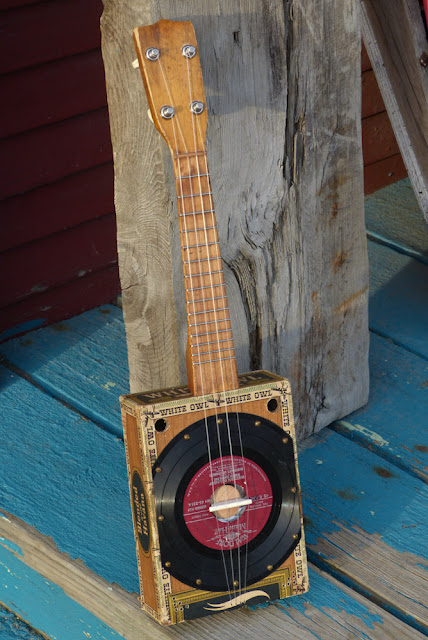1920s/2016 Cigar Box Resonator Ukulele
It's now Thursday night but I actually finished this on Tuesday morning. That shows about how efficient I've been about getting things "blogged." I've had this old banjo uke neck for a couple years now (as I recall) and the "White Owl" cardboard cigar box for several more years. Both have desperately needed use, so I whipped this up mostly over part of an off day.
The neck got a plane/refret, I routed a hole in the top of the cigar box to mount a 6" resonator, and I cut a maple "dowel/body brace" that runs through from the bolted neck to the "endblock" area with a section cut-out to allow for the resonator's bottom. Fortunately we have a lot of old scratched-up 45s in the shop as decoration so I used one for a "coverplate" and sanded-down the edges to fit the box's edges. It's a nice, lightweight, solution.
Our kids love this thing -- it's got a charming, driving tone that has volume around the level of a nice old 50s Kamaka (those things are darn loud) but without the worry that you're going to knock a fancy uke about on a picnic or whatnot. I'd say that's leaps-and-bounds better than the average cigar-box uke project which are usually frightfully underpowered (but perfect for strumming late-night).
This one has a 13" scale which was normal for a 20s uke neck (though 13 5/8" to 13 7/8" is common for sopranos these days) and so to get higher tension on the cone I tuned it up to ADF#B which, tonally, it seems to be happiest with -- and gives it a more individual voice, anyhow. I expect that something like Worth "fat" strings for GCEA would do the trick, too, though.
The tuners are parts-bin friction units and work just fine. The nut is wood.
Upside-down just for fun! The cone and "biscuit" setup is the same as used on this baritone reso uke I made-up, though the saddle on this one is bone.
By using a big block of maple as a banjo-style "dowel" inside, the whole uke is very sturdy and practical for regular use.













Comments